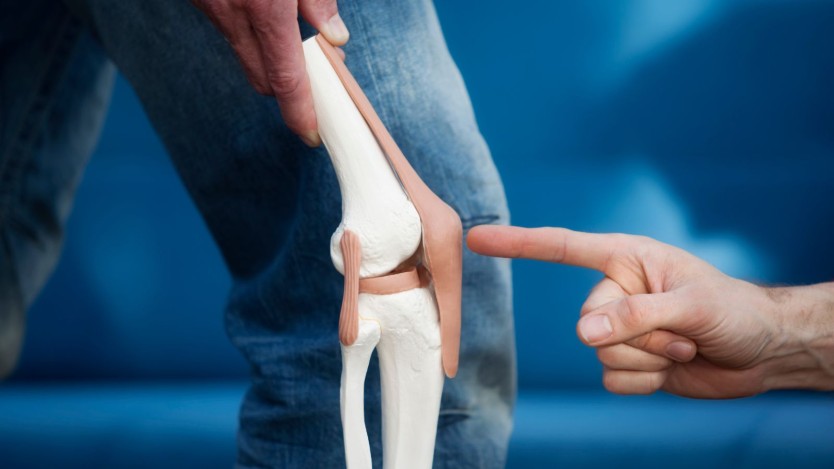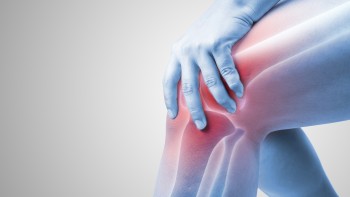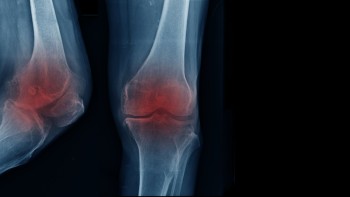How is a meniscal tear diagnosed?

- How does the meniscus tear?
- How do I know if my knee pain is caused by a meniscus tear?
- What questions will the doctor ask to diagnose the rupture?
- Physical examination of the knee
- Medical tests to diagnose a meniscus tear
- Treatment for meniscus tear
- Bibliography
- Source information
- A meniscal tear can be diagnosed by physical examination and magnetic resonance imaging.
- In specific cases of doubt, the specialist may opt for exploratory arthroscopy to ensure that the symptoms present are due to a meniscal tear.
- Whenever the diagnosis can be assessed and the situation requires it, the specialist will opt for surgical arthroscopy.
The diagnosis of a meniscus tear is made by means of a physical examination of the knee in which the intensity of the symptoms and the patient's general state of health are taken into account.
An MRI scan is also performed to determine if there is a tear and, if so, to determine the severity of the tear.
From this point, the specialist can recommend treatment based on rest and medication, or surgery. However, a meniscus tear is not the only injury that can occur in this cartilaginous tissue, so it is important to diagnose it before starting any treatment.

Free Assessment for Contracting Medical Services
Operarme’s Patient Service will contact you and solve all your questions on the medical service you need.
How does the meniscus tear?
First of all, it is important to know what the meniscus is. It is a kind of cushion between the femur and the tibia, formed by a cartilaginous tissue similar to the one we have in the upper part of the ear. Its function ranges from assembling the joint and preventing friction between the two bones, to cushioning blows.
Although meniscus tears are very common in sports involving aggressive knee movements, such as football, basketball or tennis, it is true that they do not always rupture due to a complex movement.
One of the most common injuries in the world of sport is the meniscus tear.
Sometimes menisci are torn by a simple movement in the daily routine, where the foot is placed on the ground and the body rotates. At that moment, the meniscus tears.
On the other hand, people who work or spend a lot of time squatting, with their knees bent and strained, when they stretch their knees, the meniscus does not return to its place properly and can get trapped between the femur and the tibia and can tear.
Sometimes the symptoms of a meniscus tear are very vague and it is not possible to suspect the injury. In fact, while some patients with a torn meniscus can continue to play sports, others are unable to walk.
How do I know if my knee pain is caused by a meniscus tear?
Although meniscal tears are one of the most common knee injuries, they are not the only ones. The joint has more structures that can be damaged, as well as diseases that can cause confusing symptoms when it comes to finding out where they come from.
Thus, there are a number of circumstances and symptoms that are very characteristic of meniscal tears:
- Traumatic history. The tear is usually caused by a blow, accident or movement. In addition, you will probably remember when it happened.
- Pain on the inside of the knee. It is very common for a meniscus injury to occur on the inner side of the joint, or in the posterior area, i.e. the back, where the knee bends when flexed.
One of the most common meniscal tears is injury to the posterior horn of the inner meniscus:
- Synovial fluid. This fluid is found inside the synovial membrane and helps lubricate the joint. When the meniscus tears, a lump may appear at the back of the knee, due to the leakage of this fluid. A lump known as a Baker's cyst.
- Inflammation of the knee. The leakage of synovial fluid causes swelling of the joint area, making it impossible to bend or fully straighten the knee.
- Locking of the knee. Patients with a meniscus tear have locking or locking. In addition, in some cases, a meniscus fragment may be the cause of this joint locking.
- Sudden failure or loss of strength. Lack of stability arises when the meniscus is torn.
- Pain on full knee flexion. This is the most common symptom of all and is not always caused by inflammation of the synovial fluid, in which case it will be difficult, if not impossible, to straighten or bend the leg to its maximum angle without pain.

Unlike osteoarthritis, a meniscus tear…
- It occurs at any age, whereas osteoarthritis of the knee tends to occur in older people.
- It has more localised pain than osteoarthritis (global joint discomfort). Although in the initial phase of the rupture, global tightness may be felt, the pain is usually felt on one side of the knee, with the inner and back side being more common.
- It does not cause joint deformity. In contrast, osteoarthritis is a global deterioration of the joint, so it is linked to this deformation.
- It does not affect the other structures. In the worst case, the rupture can cause tendonitis. However, osteoarthritis involves the ageing of the entire joint, reducing mobility, etc.
- It has a traumatic antecedent, i.e. the meniscus tear is usually caused by an accident or a movement of the body on the knee.
- It presents greater instability or sensation of blockage than osteoarthritis.
- It is diagnosed with more specific tests. However, to diagnose osteoarthritis, an X-ray and the patient's combination of symptoms will be sufficient.

Do you have a meniscus tear?
Request a free and immediate appointment with our specialists in Traumatology and get a surgery date
What questions will the doctor ask to diagnose the rupture?
Symptoms such as pain and the inability to move the knee are what prompt the patient to go to the doctor to find out where the pain is coming from and, of course, to find out the seriousness of the injury.
It is therefore important to know that the specialist will ask a series of questions to diagnose a meniscus tear:
- At what point did the injury occur?
- What were you doing at that moment?
- Did you feel a pop or did you have the sensation of a popping sound?
- Did your knee swell?
- Have you ever injured your knee before?
- Do you have symptoms from day one or are they occasional?
- Are there movements that relieve or bother you more than others? Which ones?
- Do you feel your knee lock when you try to move it?
- Have you felt a loss of strength or stability in the joint?
In addition to this, the specialist will palpate the joint area and perform a series of movements to check that the knee injury is due to a meniscus tear.
Physical examination of the knee
The diagnosis of a meniscus tear is based on an examination of the knee. In this way, the specialist will check if there is deformity in the knees, if there is effusion, as well as how much mobility is lost in the knee, compared to the other leg.
The specialist will then ask you to undress your legs and walk in different ways: normal, on tiptoe, on your heels, as well as squatting etc.
You will then lie down on a stretcher and the specialist will check for effusion, check the condition of the muscles and check the mobility of the knee. At this point, various exploratory manoeuvres are carried out to find out if the origin of your symptoms is a meniscus tear.

McMurray Test
The McMurray test is a test performed to assess a possible meniscal injury. But what does the McMurray Test consist of?
First of all, you must lie on the table on your back and bend your knees. The specialist will be in the homolateral position with one hand on the joint interline and the other on the malleolar area.
At this point, the specialist begins to perform an almost full extension of the knee while rotating it inwards and outwards, depending on the meniscus to be assessed.
Finally, the specialist will perform a series of tests to confirm that the symptoms in the joint area are caused by the meniscus tear.
Medical tests to diagnose a meniscus tear
X-ray
This is a quick and painless test in which images are taken of the internal structure of the body to check the condition of the bones.
Thus, the specialist will observe the bone structure, whether there are valgus or varus deformities and the space between the ends of the femur and tibia.
However, in cases of meniscus tears, the X-ray is insufficient, as it is not visible.
Magnetic Resonance Imaging
Magnetic Resonance Imaging (MRI) is the test most commonly used to diagnose meniscus tears. Using radio waves and a magnetic field, very detailed images are made of the hard and soft tissues of the knee.
This test provides very valid information of the inside of the joint and at different angles, i.e., it can obtain views from any direction. In addition, it is a test with more contrast than any other.
Exploratory arthroscopy
In cases of doubt, the specialist will resort to diagnostic arthroscopy of the knee. This uses a camera that transmits magnified images of the inside of the knee to the monitor to which the arthroscope is connected.
The arthroscope is inserted through a mini incision made in the knee.
This surgical instrument makes it possible to see all the structures of the knee without making a large incision.
Only in very rare cases does the MRI give false negatives that will later be seen during exploratory arthroscopy.
Treatment for meniscus tear
Treatment for meniscus tears may vary depending on the cause of the injury and the characteristics of the patient.
If the meniscus tear was caused by an accident, arthroscopy is almost obligatory.
If the tear has occurred in an older person, with a less demanding sporting activity, the treatment may be less invasive. In these cases, the meniscus will not heal 100% but the patient will be able to lead a life with hardly any discomfort.
Non-surgical or conservative treatment will therefore consist of the following:
- Rest: avoid sudden movements of the knee or activities that aggravate symptoms, such as twisting or pivoting the joint. Using crutches may relieve knee pain.
- Ice: reduces knee pain and swelling. With your leg elevated, you can put a towel with ice cubes or other similar method on your leg for 15 minutes. Doing this for 4-6 hours a day reduces the feeling of joint pressure.
- Medication: your specialist may prescribe a series of painkillers to relieve knee pain.
- Physiotherapy: helps to strengthen the muscles around the knee and those in the legs to gain stability and support the weight on the joint.
Regardless of the patient's age and state of health, what will make a specialist recommend surgical treatment is the severity of the situation.
Thus, even if the patient is young and healthy enough to undergo surgery, if it is not necessary, it will not be recommended. On the other hand, if a person of advanced age is unable to lead a normal life due to the symptoms of the rupture, the specialist will evaluate the surgical option.
Surgical meniscus arthroscopy
Depending on the progress of the tear and your symptoms, your doctor may recommend surgery if you continue to feel pain despite rehabilitation therapy.
Meniscus arthroscopy involves surgically cutting the meniscus through mini incisions made in the knee.
After surgery, it will be necessary to carry out a rehabilitation process to increase the strength and stability of the joint.
If you have torn your meniscus and you have a medical recommendation to undergo arthroscopy, at Operarme we offer you a free surgical assessment consultation with the specialist to assess your case and you can start the treatment as soon as possible.
To ask any questions you may have about this, you can call us on +34 91 141 33 56 or fill in the contact form.

Do you need meniscus repair surgery?
Request a free and immediate appointment with our specialists in Traumatology
Bibliography
- Fernández Tapia, S., Hennings Hinojosa, E., & Martínez Vera, E. (2007, enero). Fracturas de menisco. Imagen por Resonancia Magnética IRM. Recuperado de https://www.medigraphic.com/pdfs/anaradmex/arm-2007/arm071h.pdf
- Fernández Alvarez, P. (s.f.). Lesiones meniscales. Recuperado de https://www.aaot.org.ar/revista/1993_2002/1997/1997_3/620307.pdf
- Pons Porrata, L. M., Diarra, I., De La Cruz De Oña, A., Salomón López, J., & Domínguez Piorno, R. (2014). Características clínicas, por resonancia magnética y artroscópica de las lesiones meniscales de la rodilla. Recuperado de http://scielo.sld.cu/pdf/san/v18n7/san08714.pdf
- Cabot, J. R. (1967). Cómo diagnosticar una lesión de menisco de la rodilla en la práctica médico - deportiva. Recuperado de http://www.apunts.org/index.php?p=revista&tipo=pdf-simple&pii=X021337176704162X
- MARCO MARTINEZ, F., PEREZ-CABALLER, A. J., SANCHEZ BARBERO, J. C., GARCÍA-HERRERA, G., OTERO, R., & LOPEZ-DURAN STERN, L. (1993). Verificación artroscópica del diagnóstico por resonancia magnética de las lesiones meniscales. Recuperado de http://www.cirugia-osteoarticular.org/adaptingsystem/intercambio/revistas/articulos/1506_213.pdf
Dr. Antonio Rebollo Marina
Médico Asistencial en Centro Médico Caser
Nº colegiado: 282834715

Medical disclaimer: All the published content in Operarme is intended to disseminate reliable medical information to the general public, and is reviewed by healthcare professionals. In any case should this information be used to perform a diagnosis, indicate a treatment, or replace the medical assessment of a professional in a face to face consultation. Find more information in the links below:



